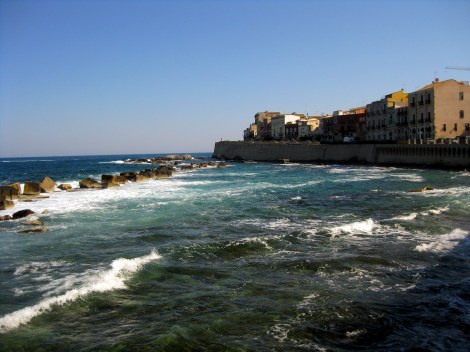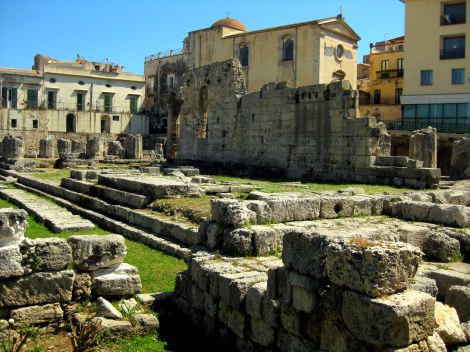
Here we are, in Syracuse, Sicily. This once powerful Greek city, founded in 733 BC, is loaded with history and culture… both Greek and Roman. In its prime it was a center of Greek, Byzantine and Judaic civilization. Today, Syracuse seamlessly blends ancient and modern.
A mere one hour bus ride from much loved Catania and we’re in a new world. After a night with little sleep, I remain in a bit of a haze while unpacking at LOL Hostel and through lunch. Once we start walking the short distance from our room to the tiny island across a small bridge called Ortygia, I start to snap out of it. Ortygia is the oldest part of Syracuse, hosting labyrinths of charming ancient and medieval streets.
Syracuse confuses me. Is it because I haven’t slept or because this Ancient city is a true blend of all the civilizations that have ruled it? Syracuse was the last stronghold of Greek culture in Sicily to fall to the Roman invaders. With the fall of Rome, followed numerous conquerors: Arabs, Normans, Spanish to name but a few. I keep thinking to myself, where are we? I haven’t gotten a good feel for the place yet. I feel like we’re in Southern Italy (appropriately), though at times it feels very French (of all places!)… often the ancient Greek roots are unavoidable… but a couple of times, by the small harbor near the bridge, I could’ve been home in San Diego. This confusing state of mind location continues as we walk in the hot sun. (Maybe I’m just delirious and/or hung-over!) Jenn and I stop at the boardwalk along the sea for a while and watch the people… the boats.. and the pigeons. Always the pigeons. Jenn tells me that the fat pigeons aren’t simply overfed, but get large as a mating attraction. (who knew?!) We watch a pudgy blonde pigeon literally harass the females. Now the birds aren’t just nasty… they’re machismo. Really, there are no redeeming qualities about pigeons. It turns out Ortygia, which means “Quail”, was named as such due to the abundance of birds on the little island.
Arethusa & Alpheios… mingling waters

Heading back onto the streets of Ortygia, we dip through tiny, picturesque alleys. Around us, people enjoy lunch and gelato gazing out to sea. Mothers round-up children. Men in kiosks sell sunglasses. We stop at an oddly placed marsh so Jenn can admire the ducks. Later, we learn this lovely, though seemingly unimportant spring, is an important features of Syracuse. The Spring of Arethusa has been popular with poets and writers went to be inspired. The mythological legend says that the river-god Alpheios fell madly in love with a nymph named Arethusa, but this love was unreciprocated. Arethusa fled from his unrelenting amorous pursuits, and eventually to save her, the Goddess Artemis transformed her into this spring. Unable to take no for an answer, stalker Alpheios got Zeus to transform him into a water source as well. Here at the spring he met up with Arethusa and forever mingles his waters with hers.
Piazza Duomo & St. Lucia Cathedral
A few blocks further along, we’re stepping into the large Piazza Duomo. This vast and spotlessly clean piazza hosts the large St. Lucia cathedral, named for the town’s patron saint Lucy. The Cathedral is built on the site of an ancient Temple of Athena, as can clearly be seen from the original columns incorporated into the façade. Continuing on, the rich history is hard to miss… from the 2,700 year old Temple of Apollo, to the Fountain of Artemis, to the easy to miss Jewish ritual baths impressively found under a hotel! These baths were only recently uncovered in 1989, after being blocked up and buried after the Jews (a quarter of Syracuse’s population at the time) were expelled from the island during the Spanish Inquisition. From here, we spend a full day walking, snacking, and ultimately joining the Italians in siesta.
Back in the room we meet a new roommate, Sarah; a 23-year-old American teaching English in Northern Italy for 6 months. She’s entertaining and joins us that evening for dinner back in Ortygia along the seaside, were I find a glass of wine and a swordfish pasta are the perfect way to wrap up a wonderful day in Syracuse.









Again, the level of detail is what makes your travel writing so addictive! And, of course, the photos are fabulous! Oh, and I really like the title too! 😉
Hee hee.. thanks for weighing in on the title choices! You would have loved Syracuse btw. Equally in awe.
Pingback: The Feast Day of Santa Lucia in Syracuse Sicily | Vino Con Vista Italy Travel Guides and Events·